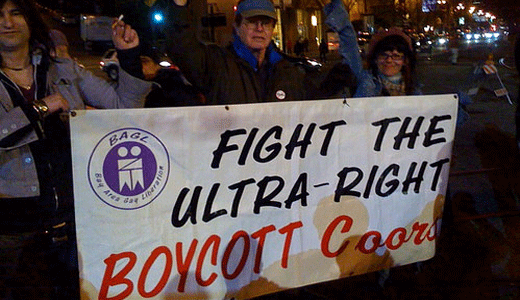
It all started with a boycott of Coors beer.
Now it’s the battle against Donald Trump.
So says Nancy Wohlforth, the longtime, now-retired Secretary-Treasurer of the Office and Professional Employees and co-founder of Pride At Work, the AFL-CIO’s constituency group for lesbian-gay-bisexual-transgender people.
LGBTQ unionists had been marginalized, or worse, Wohlforth told an AFL-CIO book talk group on June 17. Indeed, an anti-gay resolution at the 1972 Steelworkers convention got a standing ovation, she added.
But that, and the Coors beer boycott, “galvanized us,” she said. “We had to figure out how to break through this prejudice and find groups that supported us” and the crusade for equal rights.
The answer was organizing, and Pride At Work and its predecessor groups quickly showed they were good at it – and effective.
The Coors boycott got started because of the right-wing company’s 178-question employment application form.
“One question demanded: ‘Are you a homosexual?’ If you answered ‘yes,’ that terminated your application. Another demanded ‘Are you pro-union?’ If you answered ‘yes,’ that terminated you, too.”
But the LGBTQ community found its opening when the Teamsters came to San Francisco, even then a center for the gay community, to organize Coors distributors.
When that union realized the power of the LGBTQ members in the Bay Area, organizers approached a gay distributor who in turn approached colleagues – and political activists, notably the late city supervisor Harvey Milk, who was later murdered by a right-winger because he was gay.
The result: A gay bar beer boycott of Coors. It worked. “The gay bartenders marched out with the bottles of beer and dumped them in the sewers,” Wohlforth said, to appreciative chuckles from the crowd. Union President James Hoffa Sr. publically supported the gays, too.
“Coors was anti-gay, and racist and anti-Latino. And to this day, you can’t find Coors in a gay bar in San Francisco.”
The beer boycott woke other union groups up to the power of the gay community, its organizing talents, and to its proportion of gay unionists, Wohlforth explained. Other campaigns, with gays allied with unions, followed. One, in California, saw the Teachers unions and the city labor council organize to beat an anti-gay initiative, modeled on anti-gay laws pushed by a Florida referendum spearheaded by the orange juice queen, Anita Bryant.
The Dade County Federation of Teachers, and its statewide parent, were the only union on the gays’ side in Florida, and they lost to Bryant. But other unions, including the state labor federation, SEIU and the NEA, joined in California, and the coalition won. They repeated that win in Seattle, Wohlforth added. They even repeated it in Utah, with CWA’s help, later.
But those wins didn’t bring automatic acceptance within the labor movement. The LGBTQ community realized it needed its own AFL-CIO constituency group, so its representatives – Wohlforth and others – started touring the country, talking to local unions and labor councils and promoting equal rights for all, including LGBTQ members.
They also enlisted the federation’s other constituency groups, for women workers, African-Americans, and Latinos, to lobby for them. They even got pro-gay AFL-CIO and AFSCME resolutions, but those didn’t include transgendered people.
“So we created a committee for a second big March on Washington in 1987. It brought in 500,000 people, with the AIDS quilt. The lead speaker was César Chavez, a devout Catholic,” Wohlforth says. Joining him: Dolores Huerta, Barbara Streisand and Whoopi Goldberg.
It took another seven years after that, a huge parade with the gay movement flag down Fifth Avenue in New York City, and the enlistment of top union leaders Linda Chavez-Thompson, John Sweeney, Andy Stern, Clayola Brown and Bill Lucy, but Pride At Work finally had a charter and a founding convention. “We knew we needed labor on our side,” Wohlforth adds.
And Pride At Work still needs labor on its side, even though the U.S. Supreme Court, a year ago, said gays have an equal right to marriage and benefits of marriage. “As Orlando shows, for every two steps forward, we take one step back,” referring to the massacre of 49 people at the gay nightclub in the Florida city just days before.
And that’s not the only problem. Current Pride At Work Executive Director Jerame Davis noted that after the High Court’s ruling, some workplaces went the other way and ordered their couples – straight or gay-to get married or lose domestic partner benefits. So unions must work on contract language to protect those benefits, he explained.
Which leads to anti-gay ordinances – 200 proposals in 47 states, including so-called “religious freedom” statutes. Which leads, Wohlforth says, to Donald Trump.
Prejudice is still “out there, fed by corrupt politicians, led by that moron at the top, Donald Trump. We need to go after this scourge.”
Photo: Bellarmineforum.org










